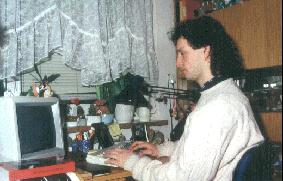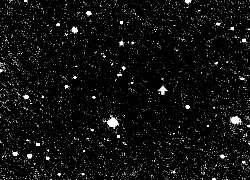A free update to version 3.25 is available for registered users on the User Info Page page !
This page offers:
General Information:
"Astrometrica" is a tool for scientific grade astrometric and photometric data reduction of CCD images. It reads SBIG (ST-4, ST-4X, ST-5, ST-6, ST-7 and ST-8), Cookbook (CB 211 and CB 245), HiSys (HiSys 11, 22, 24, 33 and HiSys 44), FITS (8 bit, 16 bit and 32 bit Integer files) and TIFF (8 bit and 16 bit uncompressed grey scale) image files up to 2048 x 2048 pixels in size.
The selection of reference stars is done with the CCD image displayed simultaneously with a star chart, usually based on the Guide Star Catalog (GSC), the USNO-SA2.0 or the ACT catalogue, oriented and scaled to match the CCD image. After the reference stars have been selected, the position and magnitude of any object on the CCD image can be measured with just a few keystrokes.
Furthermore, the program may be used to calculate detailed ephemeris of minor planets and comets. Also, "Astrometrica" allows the user to blink compare images to search for moving objects (minor planets or comets), or those that vary in brightness (variable stars, novae or supernovae).
"Astrometrica" is currently used in more than 30 countries on five continents. It has been used, for example, by Roy A. Tucker at the Goodricke-Pigott Observatory, Tucson, Arizona, to discover 1997 MW1 (M.P.C. Press Information), the first Aten-type asteroid ever discovered by an amateur astronomer. It has also been used by Warren Offut at the W & B Observatory in Cloudcroft, New Mexico, for the first observations of Trans-Neptunian Objects (M.P.C. Press Information on 1996 TL66 and 1996 TO66) by an amateur astronomer, and for for observations of S/1997 U1 and S/1997 U2, two very faint, distant satellite of Uranus discovered in September 1997 (see IAUC 6764).
Among the professional astronomers using "Astrometrica" is Dr. Paul Weissman from the JPL, who used a 2048x2048 CCD at the Palomar 200" reflector for his observations of comet 46P/Wirtanen (target of the "Rosetta" mission in 2012). He writes: "We reduced our images of periodic comet Wirtanen from last year, and then we asked Don Yeomans to check them against an ephemeris for Wirtanen. The residuals for every position were sub-arc second. I have to tell you that I am very impressed with this performance. [...] It is not just a matter that your programs work very well, but they are extremy user-friendly, and thus easy to learn and use."
Further information on CCD astrometry with "Astrometrica" can be found in the Winter 1995 issue of "CCD Astronomy" magazine (published by Sky Publishing Corp., but discontinued in early 1997), pp.20-22. Also, note Dennis di Cicco's Commentary "Tracking Barnard's Star" in that issue (p.50), as well as Brian Marsden's Commentary "CCDs and Comet Hale-Bopp" in the Fall 1995 issue of "CCD Astronomy" (p.50). A fine article on "Hunting Asteroids", also by Dennis diCicco (who has already discovered 100+ minor planets using "Astrometrica"!), is featured in the Spring 1996 issue of "CCD Astronomy", pp.8-13. Finally, the Minor Planet Center of the IAU provides a fine "Guide to Minor-Body Astrometry" online, which includes a huge amount of useful information for both beginners and advanced observers.
Results:
 Typical Residuals - Click for larger plot (6kB)
Typical Residuals - Click for larger plot (6kB)
Since the beginning of it's development in 1993, "Astrometrica" is in constant use by the author and his friends, Erich Meyer and Erwin Obermair. Using a ST-6 CCD camera on a 30cm f/5 Schmidt-Cassegrain telescope, they have measured more than 2500 positions of minor planets and comets in that time. The graph visualizes the residuals (that is, the difference between the observed and the calculated positions) from 550 minor planet observations as published in the Minor Planet Circulars (MPCs) between 1995 and 1998: 80% of these observations have residuals less than 1.0" (green circle), 97% differ by less than 2.0" (yellow circle), and the largest total residual is 4.0". Note that, with the confoguration used (ST-6 at f=1500mm), the size of a single pixel corresponds to 3.2" x 3.7", as indicated by the gray rectangle.
System Requirements:
"Astrometrica" requires a PC compatible computer with 80286 (or later) CPU, DOS 5.0 or later, VGA or VESA compatible SVGA graphics card, Microsoft compatible mouse, and at least 1 MB of XMS memory (more for large images).
Although "Astrometrica" can read reference star data from ASCII files, a copy of either the GSC (available, for example, from the "Astronomical Society of the Pacific"), the USNO-SA or the ESA Tycho catalogue is highly recommended. Note that the original GSC is shipped on two CD-ROMs - "Astrometrica" will not work with truncated or compressed versions of the GSC shipped with some software packages!
Back to the top of this page.
If you decide to order a licensed copy, please send the shareware fee (US $ 25.-) to the author's address given below. Please send Postal Money Order, cash or cheques (in US$, draft on a US Bank, or Eurocheque in Austrian Schillings). Sorry, I can't handle credit cards. Thank You very much!
Back to the top of this page.
 Screenshot of the new Windows-based version of "Astrometrica" Click for larger image (56kB)
Screenshot of the new Windows-based version of "Astrometrica" Click for larger image (56kB)Currently, a new version of "Astrometrica" is under development and has successfully passes the first pre-beta tests. The new software runs under the Windows 32 bit enviroment, and is capable of a largely automated astrometric data reduction with only minimal user interaction. Watch this space for updated information!
Back to the top of this page.

Herbert Raab was born in 1969 in Linz, Austria, and is working as a software engineer. He has been interested in astronomy since his early youth, and became a member of the "Linzer Astronomische Gemeinschaft" (Astronomical Society of Linz) in 1983. In 1996, he became president of that club.
In 1990, he joined Erich Meyer and Erwin Obermair, who have built a private observatory some 30km north of Linz in 1978, and occasionally measured positions of minor planets there. After developing some software to support the process of measuring positions on photographic film, they regularely submitted astrometric positions of minor planets and comets to the Minor Planet Center. Early in 1993, they switched from film to CCD: Since then, "Astrometrica" is in constant use by the author and his friends. More than 2500 astrometric positions, mostly of NEOs and comets, and a growing number of discoveries of minor planets are the results of this collaboration so far.
Currently, they are using a SBIG ST-6 CCD camera at the prime focus of a 30cm f/5 Schmidt-Cassegrain telescope for their observations.
In 1994, the IAU General Assembly in The Hague elected Raab as a consultant of IAU comission 20 (Minor Planets and Comets).
For further information, see "Comets, Asteroids and Astrometrica" in Sky & Telescope, August 1997, pp.72-74.
Back to the top of this page.

In May, 1996, the Minor Planet Circulars (MPCs) announced the naming of minor planet (3184) as follows:
(3184) Raab = 1949 QC
Discovered 1949 Aug. 22 by E. L. Johnson at Johannesburg.
Named in honor of Herbert Raab (b. 1969), author of the widely-used and acclaimed Astrometrica software package. Astrometrica has enabled many amateur astronomers to participate in their own astrometric programs on comets and minor planets. Raab is a software developer and is also president of the Linzer Astronomische Gemeinschaft, the oldest amateur association in Austria. Name proposed by B. G. Marsden and G. V. Williams.
The image above was taken on May 22, 1996, by Erich Meyer and Herbert Raab. It is a composite image (total exposure: 408 seconds) taken with a ST-6 CCD camera on the 30cm f/5 Schmidt-Cassegrain telescope of the private observatory Obermair/Meyer near Linz, Austria.
Back to the top of this page.

Ikufumi Makino has supported "Astrometrica" and it's author continuously over the past years. Without his help, "Astrometrica" would not be what it is today! Thus, the author of "Astrometrica" was very pleased that in June, 1998, the Minor Planet Circulars (MPCs) announced the naming of minor planet (6245) in honor of Makino Ikufumi. The citation reads as follows:
(6245) Ikufumi = 1990 SO4
Discovered 1990 Sept. 27 by T. Urata at the Nihondaira Observatory.
Named in honor of Ikufumi Makino (b. 1944), a telecommunications systems engineer and active amateur astronomer. His extensive knowledge of computer technologies has enabled him to contribute to astronomical magazines many articles about systems for making observations. He has played an important role in introducing and spreading the data-reduction tool Astrometrica in Japan. He is a collaborating member of the Nihondaira Observatory.
The images above were taken by Ikufumi Makino himself on April 9, 1999, using a 20cm f/6.3 Schmidt-Cassegrain Telescope. Click on the tumbnail to see the moevement of the asteroid during the 46 minutes between the two images!
Back to the top of this page.
Minor Planet Center (MPC)
This site offers lots of interesting information about minor planets. For active observers, the lists of critcial minor planets, the list of unusual minor planets, the a list of recently discovered near-earth object's in need of confirmation, the ObsPlanner tool to coordinate the observations of soon-to-be-numbered minor planets, as well as the Minor Planet Checker to identify unknown asteroids, are most useful.
Central Bureau for Astronomical Telegrams (CBAT)
This site offers, amongst others, a guide on how to report a discovery in general, and the discovery of a comet in special.
Lowell Observatory Asteroid Observing Services
This page offers ftp access to a huge database of orbital elements of minor planets, and allows to run several useful programs (from accessing star catalogs to calculating an observing strategy for an asteroid) over the net.
Asteroid Radar Research Page
Tired of seeing asteroids as tiny dots in the sky only? Visit this page for a trip to some of these alien worlds, and have a look at the exciting 3D models and amazing animations derived from these radar-observations!
National Space Science Data Center (NSSDC) Photo Gallery
This collection of high-quality space images also offers images of Asteroids and Comets.
Digitized Sky Survey (DSS)
The famous Palomar Sky Survey - online! Very useful for generating finder charts, or to identify suspected minor planets, comets, novae and supernovae.
Linzer Astronomische Gemeinschaft (LAG)
The author of "Astrometrica" is member of the "Linzer Astronomische Gemeinschaft" since 1983, and currenlty president of that association.
Links to web sites of "Astrometrica" users
The sites below are in alphabetic order. If you would like to see your web site listed here, please send me a message. Also, drop me a note if you find any outdated links. Thank you!
, Tenerife, Spain
Back to the top of this page.